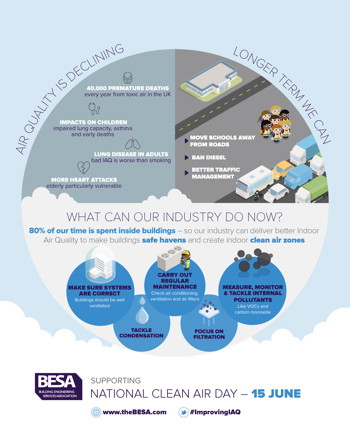Soaring asthma rate strengthens case for IAQ

Building occupants are under siege from a battery of potential health threats, according to BESA’s Indoor Air Quality group.
#ImprovingIAQ
The UK has one of the worst asthma rates in Europe with deaths linked to the condition rising by 20% in the last five years. We are now languishing fourth from bottom of the European league table with a fatality rate 50% higher than the EU average, according to research published to coincide with World Asthma Day.
An estimated five million people suffer from asthma in the UK, including a very high number of children, and falling air quality is one of the biggest contributors to this growing health crisis.
At the same time, the UK and five other nations have been referred to the European Court of Justice for failing to tackle air pollution, which is linked to more than 400,000 early deaths across Europe each year.
Along with France, Germany, Hungary, Italy and Romania, we have been issued with a ‘final warning’ over concentrations of nitrogen dioxide (NO2), which have been above the legal limit in most urban areas since 2010. The government now has until the end of this year to impose tougher air quality measures or face potential multi-million pound fines.
All of this is building up a head of steam for ongoing efforts by the building services sector to increase investment in indoor air quality (IAQ) measures for buildings.
Emergency
Earlier this year, no less than four parliamentary committees slated the government’s approach to air pollution and called for a new Clean Air Act. The Environment, Food and Rural Affairs; Environmental Audit; Health and Social Care; and Transport committees produced a joint report in which they dismissed the government’s Air Quality Plan as “box ticking” and said the pollution problem should be treated as a national health emergency.
The report came hot on the heels of a third successful legal action taken by environmental law firm ClientEarth in the High Court. It secured a ruling that UK air quality policy continues to be ‘unlawful’ because it fails to require 40 English local authorities to take action despite breaching EU pollution limits.
The committees’ report claimed that the £3bn Plan, launched by the government last year, was not addressing the fact that air quality breaches World Health Organisation (WHO) guidelines in 44 UK towns and cities. This costs the country £20bn a year because it contributes to an estimated 40,000 early deaths, the MPs said.
They accused the government of failing to take “bold, affirmative action” by opting for a compliance-led response. The Environmental Audit Committee’s chair Mary Creagh said the country needed a new Act that would continue to hold the government “accountable for failures to achieve air quality commitments after the UK leaves the EU”.
Unfortunately, most measures envisioned by pollution campaigners and politicians focus exclusively on methods for reducing outdoor pollution. While that is clearly the right way to go for the long-term health of the nation, speedier and lower cost measures aimed at improving indoor air and which could quickly reduce asthma cases, for example, get very little air time – if you pardon the pun.
Local and central government officials have missed (or ignored) the link between outside air pollution and building related health problems for years. Within the building engineering community we have been pointing out for some time that polluted air does not simply mysteriously disappear when it reaches a building. On the contrary, it has a catastrophic impact on indoor air quality (IAQ).
Yet, while there have been plenty of high profile efforts to measure outside air pollutants and lots of political grandstanding on the issue – there has been almost total silence on what all this means for the indoor environment. This is despite the fact that we spend most of our lives – more than 80% -indoors.

Traffic is responsible for most of the NO2 pollution imposed on building occupants. This is known to cause inflammation of the airways, reduce lung function and exacerbate asthma with particulates also linked to heart and lung diseases as well as certain cancers. NO2 alone is held responsible for more than 23,000 premature deaths every year in the UK.
Vehicles produce 42% of carbon monoxide, 46% of nitrogen oxides and 26% of particulate matter pollution – exacerbated by the now discredited policy of promoting diesel vehicles. The main focus of political pressure – and the planned new Clean Air Act – is on ultra-low emission zones in cities and vehicle emissions restrictions with total bans planned for decades hence, but what do we do in the meantime to protect people?
Invisible
The BESA Indoor Air Quality group continues to ram home the message that, while ventilation systems may be ‘out of sight out of mind’ and the air we breathe is invisible, does not make the link between airborne pollutants and increasing rates of respiratory disease less obvious. It is campaigning for indoor clean air zones to be included in the new Act.
This would help to address current anomalies like NHS technical design guidance being exclusively focused on managing the risk posed by the transmission of infections inside a building. Measures to mitigate the threat from external air and its impact on patients (most of whose immunity systems are compromised) should be a consideration for healthcare facilities.
The building engineering services industry has a wide range of solutions to offer including filtration, but also other (mainly low cost) improvements, such as upgrading fans and simple maintenance. These would not only reduce health risks to building occupants, but also do it in a way that improves the overall efficiency of the ventilation and so significantly cut running costs.
Those most at risk from poor IAQ, such as the young, elderly or seriously ill, are often demographic groups that spend the longest periods of time indoors – mostly within the growing number of urban areas that are outside WHO limits for airborne pollutants.
And, where there is a will, there is a way. For example, Stella McCartney’s new London store has just opened complete with “cutting edge” filter technology.
An air filtration system from the Danish company Airlabs claims to remove 95% of traffic fumes and residual airborne pollutants to protect staff and customers in the Bond Street shop, which suffers from high levels of NO2 – particularly at street level. The Body Shop is also using the Airlabs system.
The BESA Group continues to work on practical guidance so the building engineering industry can turn all buildings – even ones with much more modest budgets than luxury fashion retailers – into safe havens.
Creating indoor clean air zones can be done rapidly and at low cost – if everyone is clear about what is meant by IAQ and what is required to deliver it. They will also buy us valuable time as politicians wrangle over ways of cleaning up our toxic outdoor air in the coming decades.
For more information please visit the link below.








